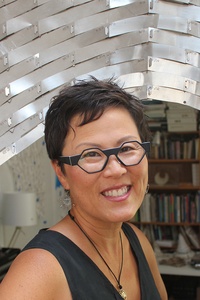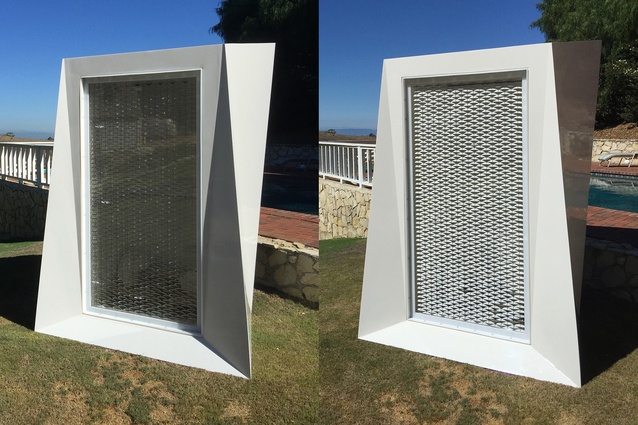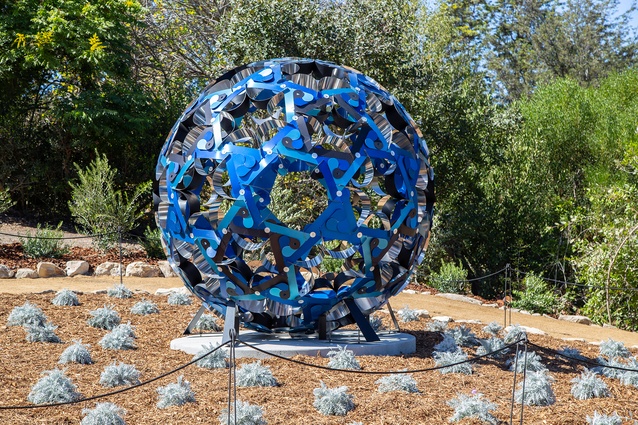Kinetic architecture
United States architect and educator Doris Sung has been exploring materials that react to weather conditions as a way to better insulate buildings and reduce the need for air conditioning. Ahead of her live-streamed appearance at BuildNZ, Sung spoke to Federico Monsalve about her research and the science behind it.
Federico Monsalve (FM) Your thermo-bimetal work seems to fall somewhere in between architecture, material science, biology, and kinetic art… is there one particular discipline you feel most interested in or one field you think has the most potential to disrupt the way we build?

Doris Sung (DS): In college, I started as a pre-med biology major. I was very interested in living organisms and systems. So, when I started studying architecture, one of my first questions was “why can’t buildings perform like biological organisms?” From the eye-rolling responses, I gathered that my early questions were more disruptive to the discussion rather than disruptive to the industry. Through the years, I have revisited the questions in different forms with only mild response. It was not until I decided to apply this idea to building tectonics on the building envelope did I start to make traction. With greater public interest in issues relating to climate change, energy conservation and computational impact, things are really starting to happen. In my case, biology influenced the way that I think. It’s smart, efficient, responsive and effective. Isn’t that what we want architecture to do too?
FM: Any kinetic artists you have a particular affinity with?
DS: David Rozin’s work is amazing and magical. I also like work by Daan Roosegaarde because it combines the phenomenal, climate and intelligence. Janet Echelman makes these beautiful public art pieces that embody air movement in a way that is mesmerising. I can’t say that their work is similar to mine, but they inspire me.
On the other hand, pangolins, leaves on trees, plant cells, porcupine quills and fish scales are probably more directly influential in my work.
FM: Was there a ‘eureka moment’ for you that lead to the development of these bimetals?
DS: Thermo-bimetals have been around for almost 100 years. They are most commonly used as the coil inside a thermostat that triggers the heat or air conditioning to go on. When I was researching the idea of using smart materials (or materials that respond by using no energy or no controls) on buildings, I came upon this material that looked similar to sheet metal. It was at that moment that I thought: ‘Here is a material familiar to buildings, thanks to Frank Gehry. But, wow, it does so much more.’ Since the manufacturing method was already well established, the cost of material was very reasonable. Since then, because I have no role model or precedent to follow, I have had many eureka moments (at least in my mind!). That’s what makes my job so enjoyable.
FM: Are there sustainability issues/hurdles you need to take into consideration while manufacturing these types of façades? (i.e if you were to manufacture at a large scale)
DS: Yes, there are, as with any sheet metal or other building materials. Everything from isolating metals to rolling them into sheets to shipping them to location requires some level of carbon footprint. However, our goal is to devise systems that are as lightweight as possible by integrating innovative structural and lifecycle strategies. That way, we are extremely efficient on the use of the material by considering the material behaviour and basic physics.

FM: What is the lifespan of these bimetals and can they be recycled?
DS: If the material is exposed directly to the elements, the lifespan is pretty short (like seven years). But, if prolonged by use of coatings or sealants then the lifespan can be extended for a very, very long time. This is true for almost all metals. In the case of our window systems (InVert Window Shading Systems), when hermetically sealed inside the cavity of an insulated glass unit (IGU), it can operate millions of times for an indefinite amount of time, with or without coatings.
FM: Besides the thermal and the aesthetic, what other areas of architecture do you feel can benefit from this type of material?
DS: I have been developing the material for self-assembly, self-structuring, self-propulsion and energy-generating.
FM: Have you been working much around structural pre-stressing?
DS: I have a few projects that begin to test the idea of pre-stressing surfaces. I combine the use of aluminium parts with thick versions of thermo-bimetal. At high temperatures (about 300˚f/150˚C) the specific thermo-bimetal will easily curl. As it cools, we constrict the piece into a bow position, which allows the structure to be very strong and very lightweight. The best part is that we design the system to only require one hand/one person to install with no fasteners or tools. This idea has potential impact on our construction industry. Very little skill and very little brute force is needed for installation.

FM: How are you dealing with the cleaning needs of these panels, do they need lubrication, and what wear and tear are you seeing?
DS: Like any material exposed to the elements, thermo-bimetal also needs maintenance. Coatings and sealants can be added that prolong the lifespan to prevent corrosion. If used indoors, deteriorating is less likely and the material can be maintained with simple dusting. Because there is a tiny amount of copper and iron in the alloys, there is some level of corrosion. On one side of the material, it will turn a velvety black. It’s actually quite beautiful.
FM: In many sustainability circles there seems to be some dislike of building materials treated with chemicals, especially in interiors. Is there a way to treat these bimetals without the need for chemicals?
DS: I agree. Human wellness should be at the top of the list of priorities. For interior spaces, the material requires very little treatment. The few items that I have designed for the interiors use raw and untreated thermo-bimetal. Most of my other products are designed for exterior or structural purposes.

FM: Are you testing these materials for different climate conditions and is there any particular climate model you feel bimetals are struggling in or need more modifications?
DS: Because I work in Los Angeles, I am more focused on hot climates. That is why I’m looking at ways to reduce the use of air conditioning by reducing heat gain in a building or by passively and automatically ventilating spaces. In climates that are hot and arid, the need for dehumidification for cooling is less of a problem. Many of my inventions target these climate zones so that users can first consider using passive methods before cranking up the air conditioning.
I have other projects that use different renditions of thermo-bimetal that react to cold temperatures. In those projects we consider methods of trapping cavities of air to increase a wall’s insulating capacity or we utilise self-structuring strategies by using swings in temperature. There are so many projects that we have and so little time to work on them.
FM: What is the holy grail for thermo-bimetals, what is the one discovery, chemical, process, et cetera that could take these materials to a new height?
DS: Wouldn’t it be great if you could 3D print thermo-bimetal parts? That would bring the materials and the shape together into one step and would shorten the multi-step process of manufacturing. It could also introduce the idea of non-uniform material where different parts of the lamination have different thicknesses. We are working on that now.
FM: Do you see the principles behind your bimetals ever influencing construction at a miniature/nano level i.e how small can you take these materials and still have them be reactive to heat and influence building interiors?
DS: I believe there are already some people who have been trying to develop the technology at a micro-level in the assembly of micro-circuit boards. The bimetal is used as a platform to move the tiny pieces into position. I’m not sure how far along they are in their research. If we can bring the micro- or nano- level to architecture, it would be amazing. We can then feel a breeze through walls and glass. We would never need to open a window to get fresh air. It would just filter through the walls (which, of course, would be chemical-free and healthy!).
FM: Let’s chat about your fellowship with Google’s R+D for the Built Environment. Your thesis there is summarised: “By using passive methods of air movement, [Sung] is working with fluid dynamic engineers to develop new types of microsurfacing for building panels that can control the movement of air on the surface of the façade so that it can be filtered chemically and by filtration.” Can you walk us through how this proposal evolved during your fellowship and some of the mechanics of microsurfacing?
DS: That is a series of new projects where I’m working on challenging the purpose of a building’s liminal surface. I proposed that the outer surface can be used as infrastructure of a city and not solely for the benefit of the building occupants or owners. Or, more specifically, it can be used for public health. So, for that fellowship, I worked on developing some architectural panels that will passively increase air movement on the surface of the building and filter smog by using basic aerodynamics and Bernoulli’s Principle. Currently, we are working at large scales so that we are able to test them in wind tunnels. Eventually, they can be scaled down. It’s the opposite of how we typically work as architects.

FM: How is your research influencing your own academic work? For example, do you think the teaching of architecture has given enough emphasis to material science, to the kinetic possibilities of buildings?
DS: Teaching architecture has kept me and my work current and relevant. I strongly believe that the academy needs to stay ahead of, if not lead, the industry. In addition, by moving away from a client-based practice to a research one, I have been able to more freely pursue crazy ideas. That way, I can both dabble in new ideas, dive deep into rabbit holes and continuously build models/prototypes/proof-of-concepts to test my ideas. I feel so lucky to have that luxury.
FM: What other areas of architecture/material science are you exploring through your research and what is getting you excited about the future?
DS: My interests are headed less to material science as they are to resolving intractable problems through architecture. I mentioned my interest in using the building surface for public health. There are so many things are building surfaces can do to contribute to public wellness. Another project that I have been working on, thanks to support from the Headlands Center for the Arts, is to use the architectural façade as a medium to affect mental health of a city. I’m designing a surface that can gesturally smile so that people will smile when they see it. There are many studies that show that smiling increases endorphins and raises the level of happiness in a person. So, if I can make many people in a city smile day after day, can’t I raise the level of mental health of a city? I have a long way to go, but wouldn’t that be something?
Doris Sung will be delivering a keynote speech at BuildNZ on 25 November 2020. For more information click here.
For Doris Sung’s website click here. Learn more about the InVert Self-shading Window System here:













